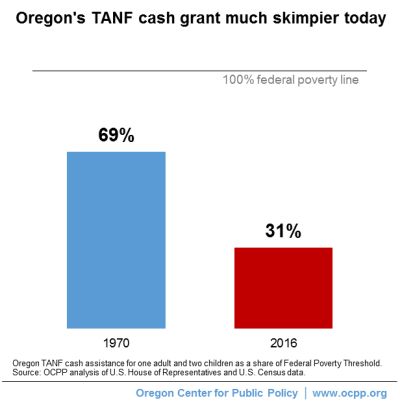Oregon families that fall on hard times get far less cash assistance today than they did decades ago. Children in Oregon’s poorest families live in precarious situations, at risk of becoming homeless and facing great obstacles in their efforts to get ahead. To protect these children and improve their chances in life, policymakers should significantly increase the size of cash grants in the Temporary Assistance for Needy Families (TANF) program.
TANF cash assistance is insufficient, having eroded over decades
TANF is Oregon’s principal safety net program for children in poverty. It helps families that have fallen on hard times, including women and children escaping abuse, avoid homelessness and get back on their feet. Only very poor families that have exhausted personal resources can get help. The program provides modest cash assistance and services, such as subsidized child care, job training, and employment supports.

TANF cash assistance is intended to meet a family’s basic needs such as food, clothing, shelter and utilities.[1] In the past, the amount of the grant, though meager, was closer to what a family needed to cover those basics. For instance, in 1970, a parent with two children and no other income could receive $184 per month — an amount equal to 69 percent of the federal poverty line.
Over time, the value of TANF cash assistance has eroded. Oregon has infrequently raised the grant amount and the increases lag far behind the pace of inflation.[2] Today, the maximum grant for a parent with two children is $506 per month, the equivalent of 31 percent of the federal poverty line. It has been at that level since July 1, 2011.
Today’s maximum grant of $506 for a family of three is far from adequate to cover basic expenses. Setting food aside, basic necessities such as rental housing, utilities, telephone, clothing, and household supplies typically add up to about $1,343 per month in the lowest-cost, rural areas of the state. Expenses are higher in cities — in the Portland metro area, costs are about $1,649 per month.[3]
A larger cash grant can ameliorate the harm of child poverty
Poverty during childhood stacks the deck against success. Research shows that the stress caused by poverty can jeopardize a child’s cognitive development, physical health, and economic future as an adult.[4] On the other hand, a modest increase in household resources for a child in poverty results in an outsized boost in adulthood earnings.[5] Therefore, boosting the amount of Oregon’s TANF cash grant could have lasting social and economic benefits for children throughout their lives.
Restructuring the cash grant would correct and prevent its erosion
To make TANF more effective in protecting children and promoting stability for parents to land and keep a job, policymakers should take several steps to fix the grant amount:
Restore the grant’s value. First, Oregon must boost the TANF grant offered to families, restoring the value of the grant lost to inflation. If the 1970 cash grant of $184 for a household of three had kept pace with inflation, it would be $1,016 today.
Prevent erosion with automatic cost-of-living adjustments. Automatic cost-of-living adjustments (COLAs) are a common feature that benefit Americans from all walks of life. They keep current such things as Social Security benefits, income tax brackets, and Supplemental Nutrition Assistance Program (SNAP) benefits, to name a few. An automatic annual COLA for Oregon’s TANF grant would improve the effectiveness of the program in the same way a COLA does other important social structures.
Offer a housing allowance. Housing costs have skyrocketed in much of the state and typically comprise the largest portion of a low-income family’s budget. Oregon could help TANF families with these costs by adding a housing allowance to the grant pegged to area fair market rents.